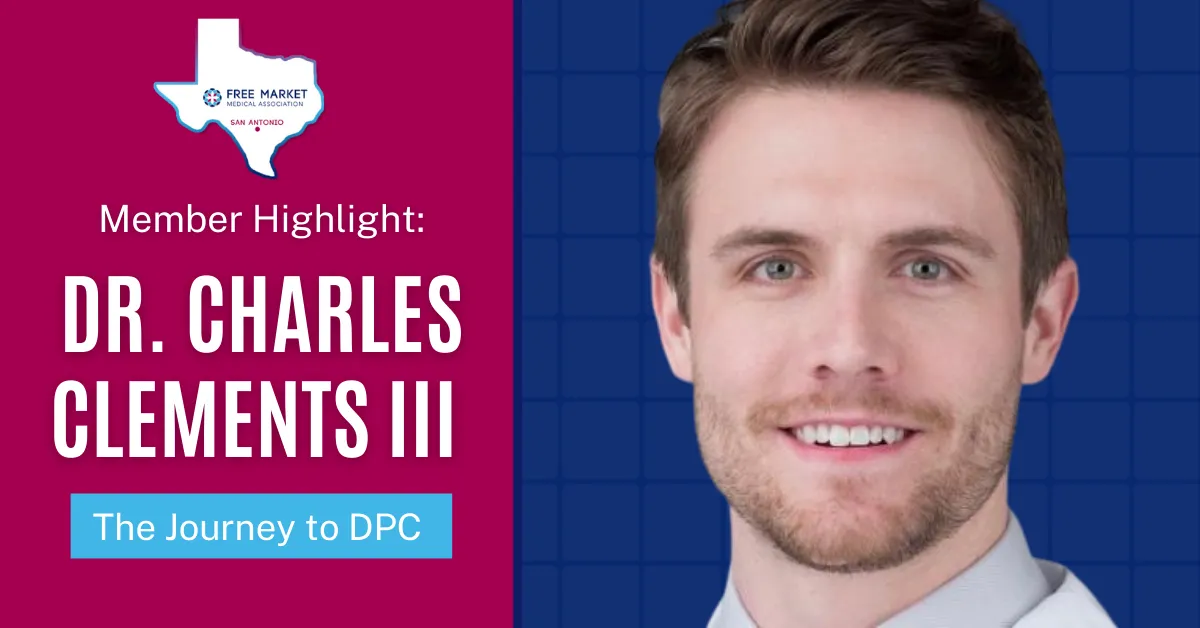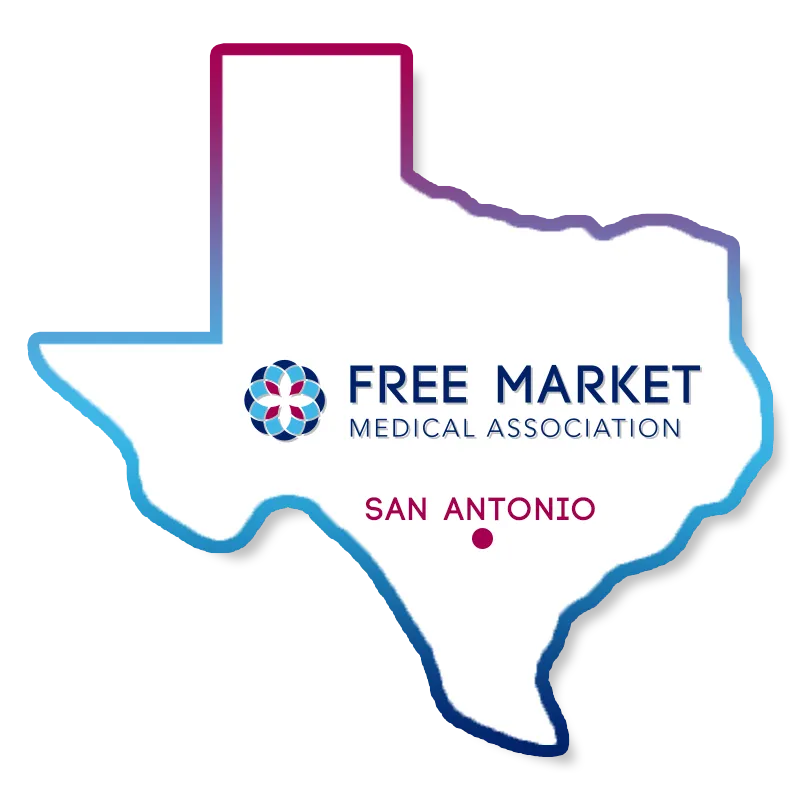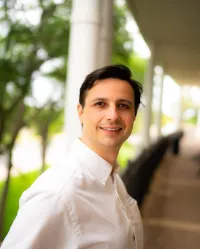Contact Us
sanantonio@fmma.org
Follow Us:
Our Blogs

San Antonio FMMA Member Highlight: Dr. Wes Clements of Tailored MD
Member Highlight: Dr. Wes Clements
FMMA Member Highlight
The purpose of our member highlights is to shine a spotlight on outstanding individuals who form part of a groundbreaking network as members of the revolutionary San Antonio Free Market Medical Association. For our June 2022 issue, we chose to highlight Dr. Charles “Wes” Clements, founder of Tailored MD.
The young adult phase of a person often shapes and sets those initial for people that they take in life. Tell us a little about that phase of your life.
“I’m actually from West Virginia…a pretty small town about the size of Stone Oak here in San Antonio. I was introduced to medicine through ski patrol as my first kind of dabbling in medicine in general. That kind of got me hooked onto pursuing that as a career, I’d say. I went to undergrad and medical school in Huntington, West Virginia at Marshall University and then did a residency at University of Virginia. When I graduated UVA, half of my family moved to Texas and we decided to chase them all the way here to San Antonio. Texas is kind of where we set up shop here.”
Oftentimes people who are involved in healthcare, they often have their parents or close relatives who were physicians themselves. Is that the case for you?
“Yeah! So, my dad’s a family practice doc(tor). He definitely started that…he doesn’t have a family member or brother or parent in medicine, so he was a first generation and then now I’m a second generation.”
Did you enjoy your time at med school? We often hear it’s quite rigorous to get through both financially and educationally.
“Yeah, I actually like to talk about the finances of medical training a lot, because I feel like it’s not talked about enough. People just say, “Oh, worry about it later,” too much and, “No, you’ll make enough money as a doctor to take care of whatever debt you dig yourself into.”
And most of the time, that’s probably the case, but the debt can get pretty extreme so I think it’s pretty important for future medical students, future trainers in medicine, to consider the debt load when they take on. I love to talk to students about that actually, especially when they’re undergrads and they haven’t started medical school yet because there’s some moves they can make that’ll probably help them out.
But, fortunately, I made the decision to stay in-state in West Virginia for my undergraduate degree, so there were great scholarships available for people who were in-state so it didn’t accumulate much debt at all in that phase of my training. Then, yeah, medical school is expensive, and it’s rigourous, and you definitely can’t hold a job while you’re going to medical school, so it’s pretty much living off of a loan at that point.
I think, at the time that I graduated, it was like $180,790 was the average medical student debt. I think it’s way over that now, probably like $300,000-$500,000 in debt by the time they finish.”
So, we actually met through the San Antonio FMMA, and know that you adopt the same model as them in your clinic. Did you start out like that or did you start off with what we call a “traditional healthcare model”?
“So, I graduated, like most students, with a lot of debt, so I was really drawn to the high salary, just work for insurance, work as an employed physician, and get a big bonus so I kind of just chose the highest paying position I could find in the private sector medicine and traditional-based insurance practices. The debt’s scary, so you don’t really want to go and start a risky, or what appears to be a risky, venture and starting your own practice with that kind of debt already.
So I went through that traditional route for two years before I made a change to Direct Primary Care (DPC). We continued to live like residents mostly for those two years, so we were able to pay off that debt and create a buffer to start a practice.
That’s why I actually really love to talk about (medical school debt). It’s just something that a lot of people are just not comfortable talking about, but I think we are all interested in it. I’m really passionate about it because I think that the debt really affects doctors and clinicians’ position on what they’re going to do with their career, whether they realize it or not.
Why do you think that so many doctors are discouraged from venturing away from traditional healthcare?
Well, (with DPC) you’re not going to get paid as much in the beginning and it’s scary to go into that position. …I don’t think we should expect anybody to take on a business model concept just out of the goodness of their heart. I think that for a real solution in healthcare, which I believe DPC and Free Market Medicine to be, I think it has to be economically feasible and attractive to the people working in that system.
Like, it was clear to me I really wanted to do Direct Primary Care, it just wasn’t in the cards for me because of the debt. I think that, if people get themselves into a better position financially, and they don’t let themselves get too far behind, then they have the freedom to do a model of care, like DPC.”
So, what is your business model?
“I think our flavor is kind of the main flavor for what’s called “Direct Primary Care” or DPC. So, we provide primary care services like any other primary care clinic, but instead of billing insurance, we charge a simple, monthly fee of $100 that covers everything in the walls of our clinic. It’s a membership-based model of care, and a lot of people confuse it with concierge medicine because both are out of pocket.
For concierge, they pay insurance and they pay a fee on top of that, generally a retainer fee, so it’s more expensive. It’s often for more affluent people who can afford and just want better service. People confuse us with them because we offer better service. We offer 30-60 minute appointments, same or next day availability. Half of the time, there’s no wait time whatsoever and you always have your clinician, you don’t just see whoever’s available. It’s not “assembly line medicine,” like I call it.”
So, it’s concierge-level care, but without the heavy price tag that comes with it?
“Yes, we get people looking for concierge services, plenty of affluent people looking for great medical care. But we also get people who can’t afford a traditional practice, we get lots of people who don’t have insurance, and lots of people, like almost everyone nowadays, who have high deductible health plans where, if they went to another practice, they may pay several hundreds of dollars. Whereas, if they pay us the same, they get entire months of care, even if we see them four times in a month, the $100 covers it.
One other service we add on that’s great for people without insurance or high deductible care is we’ve created kind of a network of cash pay services in the San Antonio area where if somebody needs something, and they don’t have the insurance, we can get them a fraction of the cost for that service. So, if somebody needs a simple blood test, 90% of the blood tests we offer are $5 each, thyroid check is $5, A1C for your diabetics is $5, etc. A panel of labs that costs, let’s say $25 with us, would cost $200-$300 usually (with other clinics).”
So, do you think it’s important for organizations like the Free Market Medical Association to be around in order to create more educated consumers in the healthcare space?
“Yeah, I think these programs are so important in terms of changing medicine for the better and making people aware of these things. …I’m lucky because I’m in the field, so I know where to find discounts and stuff, but people can hire that for themselves by having a Direct Primary Care clinician for them at one of the five or six Direct Primary Care clinic locations that are in San Antonio and 1,500 that are in the United States.”
Tell us a little bit about your practice. What does it look like when someone signs up for their first month with you?
“Well, we just hired a new clinician, Nicole Graber, NP, and she’s already filling up her panel of patients. We cap at between 300-400 patients per clinician, which sounds like a lot, but I had over two thousand in the traditional insurance model, so trust me, that’s good care.
So, when somebody joins, they can register directly online through tailoredmd.com, or if they have more questions they can submit a message through the message system on the website or by just calling the number it goes directly to, either myself or our office manager, Alejandra Zuniga. …they register online and then we always call them within 48 hours to schedule their first appointment once they register. We generally have same or next day availability, for even new patient appointments.
When they walk in the door for their first appointment, we greet them at the door by name because we don’t have such heavy flow that we know who’s coming in and when. So, we greet them at the door and we spend up to two hours with them for that first visit, if necessary. Although sometimes we know patients don’t want to spend two hours with their doctor, and we respect that, so we average about an hour. Sometimes we’re in and out even quicker if they just want something taken care of.
On that first visit, our main goal is to get to know their home life, their diet, their exercise habits, what they love to do, what their health goals are, if that’s weight loss or if it’s getting better control of their diabetes or if it’s just preventing disease or cancer screenings. We do all that stuff and we try to get it all taken care of effectively in the visit.
Then, going forward, we’ll usually either schedule labs if they need that or any screenings, and the cool thing is because, unlike a traditional practice, we’re not paid to just have you come in the door as much as often. We do whatever’s efficient for you. We’ll say, “okay, get labs”, and just give you a call when we get the results.
We also text our patients, so if someday needs a refill, they’ll just text us, “Hey doc, I need a refill”, and it doesn’t have to be this whole debacle…”
Any upcoming things happening with your clinic?
“Actually, I’ll take this opportunity to talk about an expansion project we have going on. We’re opening a program called SADPC, or San Antonio Direct Primary. I’ve been meaning to speak with Dr. Roger Moczygemba about this because I know he’s a big figure in the Direct Care community. So, SADPC is a coalition of Direct Primary Care clinicians to make ourselves more of a network and attractive to employers, if possible.
I think the biggest barrier to DPC in terms of expanding is the consistency in the offering, and that’s a good thing and a bad thing. The DPC movement’s about individuality in practicing medicine and individuality in the business model that works for the clinician. So it’s kind of this pull on trying to make some standardization, but not so much that the clinicians feel suffocated.
The website (for SADPC) is sadpc.com and that’s live now. There’s three clinics, myself (TailoredMD), with R2 Clinicians. There is also Bluebonnet DPC, which is opening in King Williams…if everything goes well for them, at the end of June.”
Wow, it’s pretty amazing having all of these people trying to help in this growing movement!
Yeah, it’s growing very fast, it’s kind of hitting that inflection point where it’s becoming that exponential growth, as we learned that it’s a really viable model that’s best for the two parties here, right? The patient and the person providing the care. These are the people that matter in terms of healthcare, so this isn’t worried about investors or these different private equity firms. This is true direct care. The patient’s the customer, not the insurance company.”
What do you think the next two years hold for you?
“Ideally, I hope we continue to grow Nicole Graber’s panel. Like I said, she just started this month and she is accepting new patients and that’s kind of TailoredMD’s goal. But I really hope to grow the Direct Primary Care movement in San Antonio. In terms of talking two years, grow(ing) SADPC, maybe getting another clinic on board with SADPC and get more employers. We can save employers tons of money on their insurance. Even if they want to keep insurance, there’s ways to wrap in DPC and still save 20, 30, even 40% on premiums with insurance.
So, we’re hoping to grow DPC, for the sake of the patients, for the sake of the greater economic toll of healthcare, I just see it as something that needs saving.”
To hear more from Dr. Clements about his insider’s perspective into the healthcare industry, make sure to watch the video interview, conducted by Shankar Poncelet, CEO of Shankx Web Development and a chapter leader of the San Antonio FMMA, below:
https://www.youtube.com/watch?v=X_9ahF7Rmzc
About the San Antonio Free Market Medical Association
Organized in 2019, Roger Moczygemba, MD and Shankar Poncelet came together with the goal to lower the cost of healthcare in San Antonio through price transparency, reference-based pricing, and local connection.
The San Antonio FMMA recognizes the three pillars on which the national FMMA was founded by Jay Kempton and Dr. Keith Smith in 2014:
1. Price is not a product.
2. Value is mutually determined and requires transparent pricing and quality.
3. Cash is king, the equality of price is critical.
The FMMA connects buyers and sellers of healthcare, educating and motivating them to work together based upon a mutually beneficial relationship built on the pillars. To learn more, visit https://SanAntonioFMMA.org or contact sanantonio@fmma.org
This member highlight is brought to you by Shankx Web Development and Consulting. For more information, please visit https://Shankx.com.

Follow Us
Follow Us
© Copyright 2025. San Antonio Free Market Medical Association. All rights reserved. Site by SHANKX.
